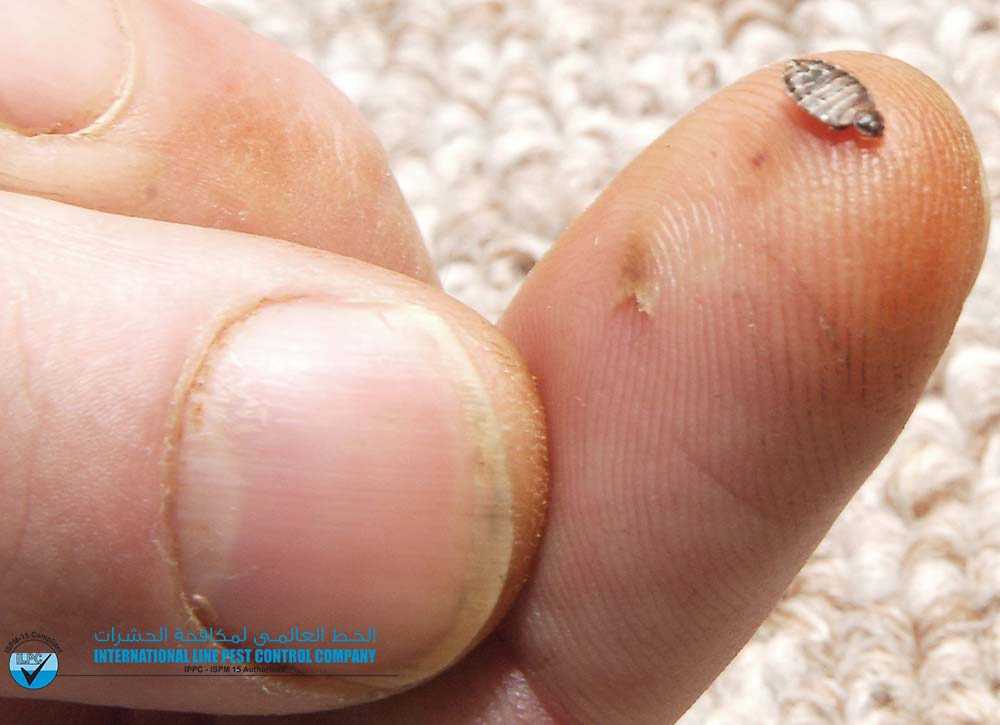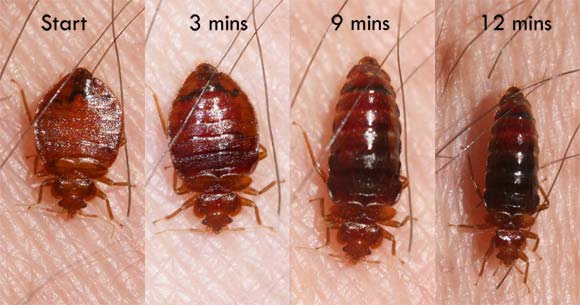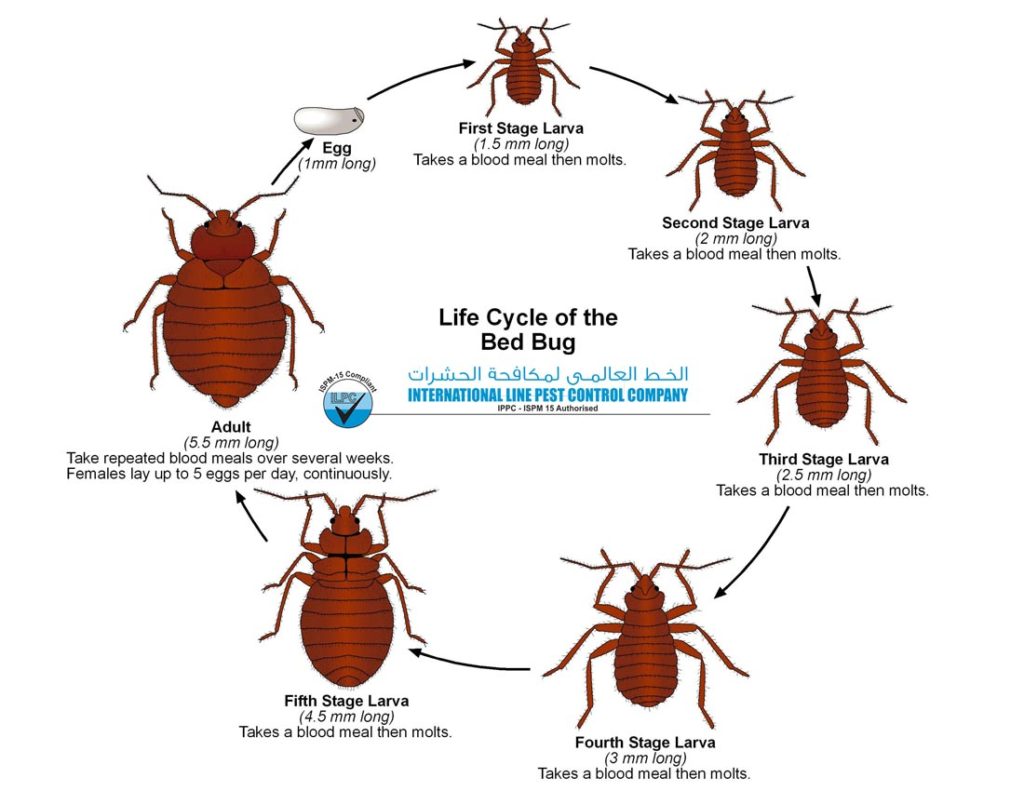Adult bed bugs, in general, are:
- about the size of an apple seed (5-7 mm or 3/16 – 1/4 inch long);
- long and brown, with a flat, oval-shaped body (if not fed recently);
- balloon-like, reddish-brown, and more elongated (if fed recently);

a “true bug” (characteristics of true bugs include a beak with three segments; antenna that have four parts; wings that are not used for flying; and short, golden-colored hairs); and
smelly, with a “musty-sweetish” odor produced through glands on the lower side of the body.
Young bed bugs (also called nymphs), in general, are:
smaller, translucent or whitish-yellow in color; and
if not recently fed, can be nearly invisible to the naked eye because of coloring and size.
Bed bug eggs, in general, are:
tiny, the size of a pinhead;
pearl-white in color; and
marked by an eye spot if more than five days old.
Bed bugs identification

The first thing that you really need to know about bedbugs is accurate insect identification.
bedbugs they’re flat they’re oval they grow up to about five millimeters in length so you can think of them the same size and shape as an apple seed okay they’re also about the same color they’re wingless they don’t jump they don’t fly so if somebody’s complaining of something jumping and it’s usually a flea if that is the case especially between the ankle and knee please not bedbugs okay so the adults as I said they’re oval shape there’s no wings they’re as flat as a piece of paper before they feed once they feed they do plump up and then also after feeding they turn more of a darker mahogany brown color.
Bed bugs life span and life cycle

Bedbugs have a lifespan of about one year. Female bed bugs lay one to five eggs per day, or an average of 540 eggs in a lifetime. They typically lay their eggs in cracks or rough surfaces. Bed bug nymphs grow to full adulthood in about 21 days and go through five stages of development before they reach maturity. A bed bug will molt once during each stage of development, though a blood meal is required for a molt. An adult bed bug can live for several months without a blood meal.
Bedbug eggs are actually whitish in color okay you can think of them as same shape as rice grains but one-fifth the size it’s hard to distinguish between a cockroach excrement and bedbug screamin especially along baseboards but if it’s in the bed you can usually tell but if you spray that excrete mint with water it actually turns back red if it’s from a bedbug we do know that eradication of bedbug infestations is also very difficult it’s also very expensive and it’s very time-consuming.
Potential health hazard
if you are living in a multi-resident dwelling you are probably yet at slightly greater risk just because of how bedbugs can travel your friends your family members could be exposed as well and you can be exposed also by travel so basically, that means everybody or anybody can potentially get bedbugs so just looking at health impacts of bedbugs currently all scientific evidence points that bedbugs do not transmit any kind of communicable disease, so they can’t transmit hepatitis B HIV or heavy.
What we do see are allergic reactions so some people have no reaction whatsoever to a bed bug bite some people have a delayed reaction so they may not see a welt or a red mark for a couple of days and some of you have an immediate reaction so as soon as they’re bitten they’ll get a red mark or they feel the intense it what we do see lots of – are secondary impact irreal infections from scratching your bite marks and recently we’ve seen about four severe anemic reactions.
Why bed bugs are a big problem?
Bed bugs treatment and preparation is also very expensive okay it takes a lot of time so imagine packing up your entire house but you’re not leaving and you can’t use cardboard boxes you have to only use plastic bags or plastic totes and you have to remain that way for at least six week period it’s not an easy thing to do.
Some people because of the extent of their bed bug problem we have to actually relocate to another unit okay all right there’s also some people who they realize they have a bedbug problem they think just moving will solve their problem.
But not. It moves with them.
There’s also the loss of belongings a lot of people out of sheer panic they throw out everything that they own and then a lot of times they do actually don’t have the money to replace those items.
Bed bugs identified, now its time for removal and control
Now that you actually correctly identified bed bugs, then comes the preparation so the preparation involves cleaning all items within the infected area as well as the surrounding area so you have to reduce any clutter so a lot of unnecessary items little knickknacks things like that all of those need to be packed away.
Because all those things create areas where the bedbugs could hide or harborage sites okay so if these things aren’t properly packed and you have to also look at them to make sure there hasn’t been any bedbugs in them because if you pack them with the bedbugs in them you’re not going to get rid of your problem and then of course after all that’s done.
There comes the treatment. Bed bug treatment consists of mechanical cleaning so that’s you know actually physically cleaning your baseboards and checking everything and then there’s the residual insecticide which consists of two sprays 14 days apart and the reason it has to be two sprays 14 days apart is because of the eggs remember I said eggs hatch anywhere between 8 and 14 days if you don’t get the second spray you will have a new crop of bedbugs that are around and able to continue the cycle.
So the sprays that we have there only effective on bedbugs that have already hatched they have zero effect upon the eggs but there’s not necessarily within those two sprays you will get rid of the problem.
It really depends on how bad your infestation was so if you catch your infestation early enough two sprays do work but other times the person may be going through this process for up to three months or longer.
Let us help you get rid of your bed bug problem anywhere in Bahrain
International Line Pest Control Bahrain

